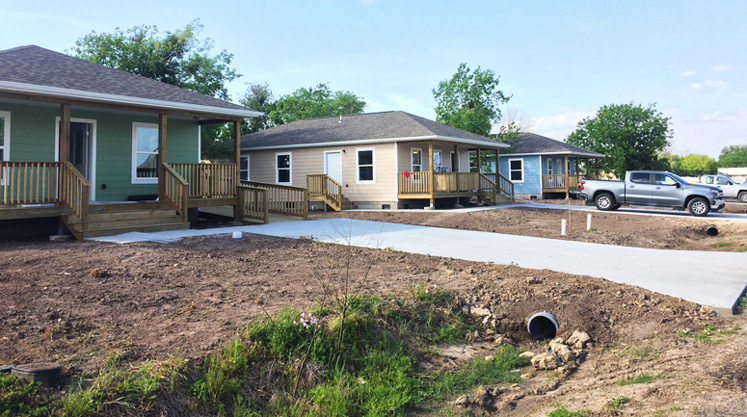When disaster strikes, and strikes, and strikes
MDS responds in a spirit of mutual aid

A hurricane pushes a wall of ocean water through your home, which teeters and collapses.
Heavy rain falls for days, and doesn’t stop until after the nearby river overflows and muddy water is knee high in your kitchen and living room.
A wildfire is moving closer to your neighborhood. You’re ordered to evacuate. When you’re allowed to return after a few days in a shelter, a charred chimney and ashes are all that’s left of your home.
Mennonite Disaster Service staff members and volunteers are heading to disasters like these on a regular basis.
In recent months, MDS responded and continues working in areas of Kentucky that flooded and in parts of Florida devastated by Hurricane Ian.
And these crews won’t hammer a few boards together, call it good and head for home.
Between 3,000 and 7,000 volunteers work on MDS projects in a given year, serving for a week or more.
“We are volunteer-centric,” is how Kevin King describes the organization, which has 29 staff members in the U.S.. King is Executive Director of MDS.
About a third of the staff members are in the field, with the rest at the headquarters in Lititz, Pennsylvania, north of Lancaster.
Going back to 1950
MDS traces its origins to a Mennonite Sunday school class picnic in Kansas in 1950. Members of the class in Hesston were enthused about helping others but thought a more formal structure might be helpful.
Sunday school classes from two Kansas communities – Hesston and Zimmerdale – formed a committee to respond disasters. It was known as the Mennonite Service Organization.
Discussions focused on some of the basic “how should we do it?” issues, such as who was available to help after disasters, what kinds of skills they had and how quickly they could leave when the need arose.
Word spread, and the MSO expanded to Anabaptist communities across the U.S. and Canada. The organization’s name became Mennonite Disaster Service in 1952.
Within three years, MDS became part of Mennonite Central Committee. The people involved started concentrating more on training field directors, and radio equipment was acquired in 1960.
By the mid-1960s, officials from the Red Cross expected MDS to show up at the scenes of natural disasters.
MDS becomes its own nonprofit
MDS was still a part of MCC until 1993, when it was incorporated as a 501(c)3 nonprofit on its own (MDS Canada in 1994). While MDS concentrates on disasters in the U.S. and Canada, MCC continues to respond to needs in other parts of the world.
A large share of MDS volunteers come from Mennonite, Amish and Brethren in Christ churches.
Kevin has been with MDS since 2004, after serving about 20 years with MCC internationally and at its headquarters in Akron, Pennsylvania.
Kevin grew up on a farm and saw how volunteers from the area would pitch in to help if a barn burned.
His father was a volunteer for MDS – including responding to the Goshen, Indiana, area after the Palm Sunday tornadoes in 1965.
Kevin said, “He’d come home and regale us with stories – tell us about how the wind was strong enough to embed a piece of straw in a tree.”
More demand for disaster relief?
Is MDS busier than ever or does it just seem that way?
The U.S. saw 15 separate weather/climate disaster events in the first nine months of 2022 that each caused $1 billion or more in damage, according to the National Centers for Environmental Information, part of the National Oceanic and Atmospheric Administration.
And insurance industry loss costs related to natural disasters have soared by almost 700% since the 1980s, according to the Insurance Information Institute.
“The number, frequency, size and scope of major disasters have definitely increased since I started in 2004,” Kevin said.
Climate change is one of those hot-button topics, and people often disagree about how dramatic it is or what’s causing temperatures to rise.
“If I’m in front of a group, I’ll say, ‘There is climate change,’” Kevin noted, and points to statistics on increases in natural disasters since 1980.
Everyone may not agree about how much people are contributing to climate change or what we should do about it, but it is happening, he said.
Changing conditions, changing response
“It has impacted the way we respond” in some cases. Floods in 2016 in West Virginia are an example.
MDS was repairing homes along creeks, but realized it made sense to help residents move out of their flood-prone area to avoid repeated high-water disasters.
“We partnered with local organizations to build 26 new homes to move people out of the flood plain,” Kevin said.
MDS built two villages of new homes in a hurricane-prone part of Texas too; the houses there are built to withstand winds of up to 165 mph.
The increasing need for post-disaster help is reflected in the size and capabilities of MDS.
When Kevin arrived at the organization less than 20 years ago, “we were five people then. Now we have more staff, more vehicles, more tools.” “We are so grateful for the generosity of our donors, volunteers and prayer partners” he added.
Coalition aids coordination
MDS is part of a coalition called National Voluntary Organizations Active in Disaster (NVOAD), which helps coordinate disaster response when multiple agencies are involved.
Some of the 74 national VOAD members include American Red Cross, Church World Service, Catholic Charities, Feed the Children, and Habitat for Humanity.
As long as natural disasters strike, these groups and many others will respond to ease the burdens of those affected, keeping in mind VOAD’s motto – Communication, Cooperation, Collaboration, Coordination.
